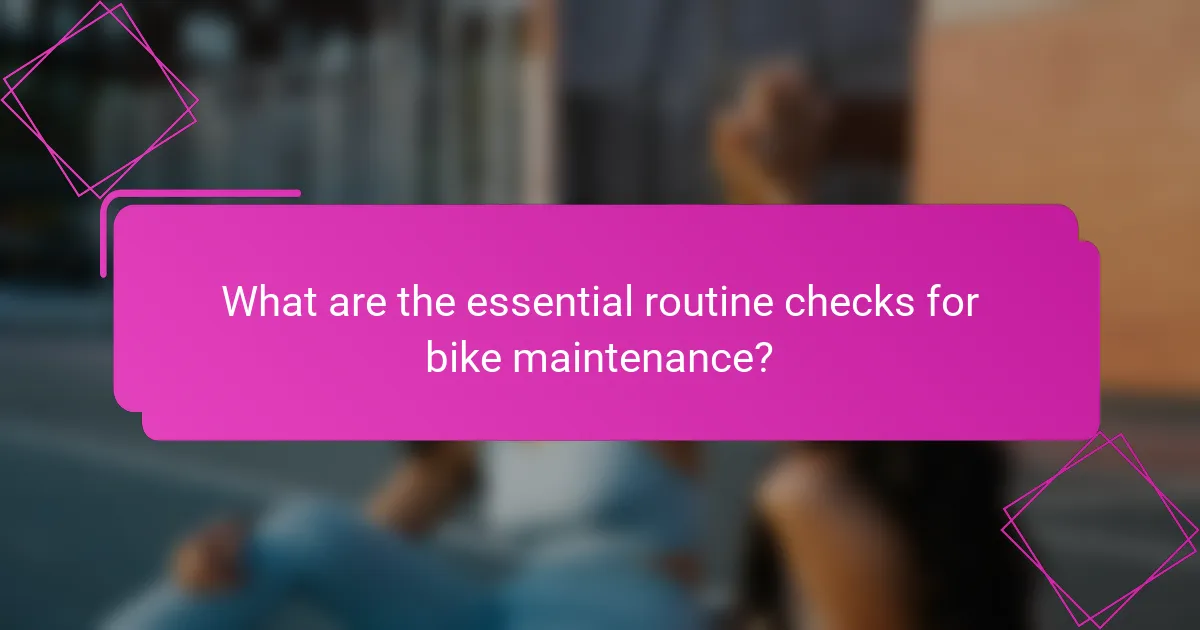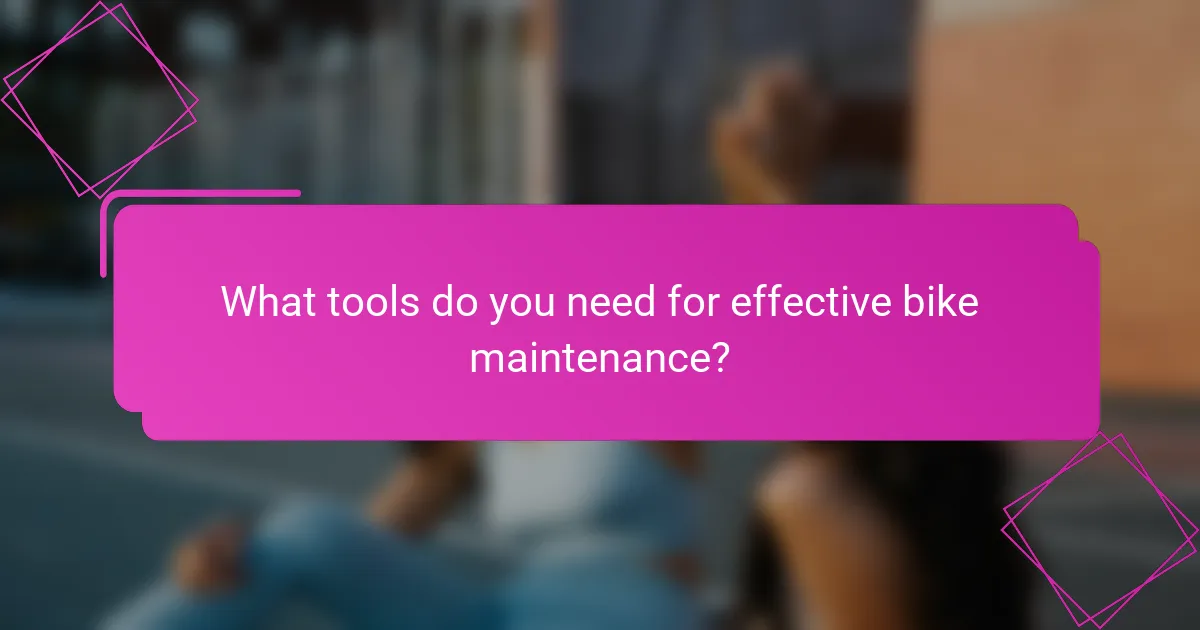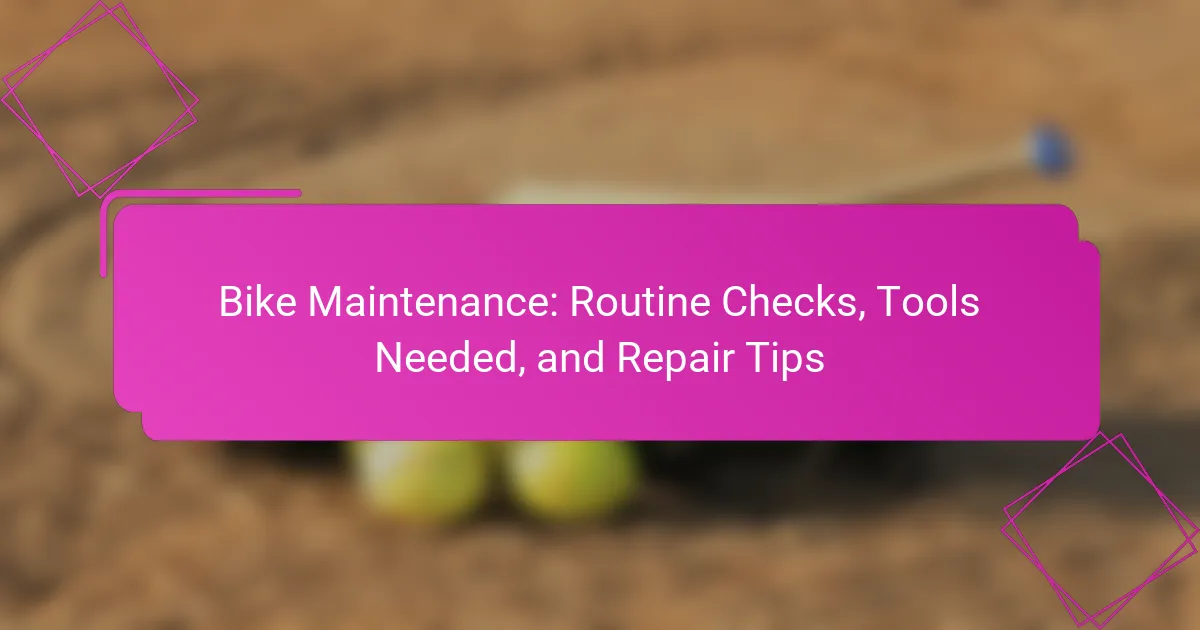Regular bike maintenance is crucial for ensuring safety and prolonging your bike’s lifespan. This article covers essential routine checks, the necessary tools for effective upkeep, and practical repair tips. Learn how to inspect key components, utilize the right equipment, and perform common repairs to enhance your cycling experience. Discover tailored maintenance strategies for different bike types and address rare issues that may arise.

What are the essential routine checks for bike maintenance?
Essential routine checks for bike maintenance include inspecting the brakes, tyres, chain, gears, and frame. Regularly examine brake pads for wear, ensure tyres are inflated to the correct pressure, clean and lubricate the chain, check gear shifting for smoothness, and inspect the frame for any damage. These checks enhance safety and prolong the bike’s lifespan.
How often should you perform routine checks on your bike?
Perform routine checks on your bike every month. Regular inspections ensure optimal performance and safety. Check tyre pressure, brakes, and chain condition. Additionally, inspect gears and frame integrity. More frequent checks are advisable before long rides or after adverse weather conditions.
Which components require regular inspection?
Regular inspection of key bike components is essential for safety and performance. Focus on the following areas:
1. Brakes: Check pads for wear and ensure proper function.
2. Tyres: Inspect for tread depth and inflation levels.
3. Chain: Look for wear and lubrication needs.
4. Gears: Test shifting accuracy and alignment.
5. Frame: Examine for cracks or damage.
6. Handlebars: Ensure tightness and alignment.
Regular checks on these components help maintain optimal bike performance and safety.
What signs indicate the need for immediate repairs?
Signs that indicate the need for immediate bike repairs include unusual noises, difficulty shifting gears, and brake responsiveness issues. A flat tyre or visible damage to the frame also necessitates prompt attention. Ignoring these signs can lead to more significant problems and safety hazards. Regular checks can help identify these issues early.

What tools do you need for effective bike maintenance?
To maintain your bike effectively, you need essential tools like a multi-tool, tyre levers, a pump, and a chain breaker. These tools enable routine checks and repairs, ensuring optimal performance and safety. A multi-tool typically includes various wrenches and screwdrivers, while tyre levers help remove tyres for inner tube changes. A good quality pump ensures proper tyre inflation, and a chain breaker is crucial for chain maintenance. Having these tools on hand simplifies bike maintenance and enhances your cycling experience.
Which basic tools should every cyclist have?
Every cyclist should have essential tools for effective bike maintenance. Key tools include a multi-tool, tyre levers, a pump, a patch kit, and a chain tool.
1. Multi-tool: Offers various functions, including hex wrenches and screwdrivers.
2. Tyre levers: Assist in removing tyres from rims easily.
3. Pump: Ensures tyres are inflated to the correct pressure.
4. Patch kit: Provides a quick fix for punctured tubes.
5. Chain tool: Facilitates chain repairs and adjustments.
Having these tools enables cyclists to perform routine checks and minor repairs efficiently.
What specialized tools are useful for advanced repairs?
Specialized tools for advanced bike repairs include torque wrenches, chain tools, and disc brake tools. These tools enhance precision, ensure proper assembly, and facilitate complex repairs.
| Tool | Purpose | Unique Attribute |
|——————-|—————————————–|————————————–|
| Torque Wrench | Ensures proper tightening of bolts | Adjustable torque settings |
| Chain Tool | Facilitates chain removal and installation | Compatible with various chain types |
| Disc Brake Tool | Assists in adjusting and aligning brakes | Specialized for disc brake systems |
| Bike Stand | Provides stability during repairs | Adjustable height for convenience |
| Patch Kit | Repairs punctured tyres | Includes various patch sizes |
| Tyre Levers | Aids in tyre removal | Durable, lightweight design |
How do you choose the right tools for your bike type?
To choose the right tools for your bike type, consider the bike’s specific maintenance needs and components. Road bikes typically require lightweight tools, while mountain bikes need more robust tools for repairs in rough terrain. Identify essential tools based on your bike’s frame material, drivetrain, and brake system to ensure compatibility and efficiency. Additionally, prioritize multi-tools for versatility and space-saving during rides.

How can you perform common bike repairs?
You can perform common bike repairs by following essential maintenance steps and using the right tools. Start with regular checks on tyre pressure, brakes, and chain lubrication. Use a multi-tool, tyre levers, and a pump for basic repairs. For example, fix a flat tyre by removing the wheel, replacing the inner tube, and reinflating. Regularly cleaning and inspecting your bike helps prevent larger issues. Always have a repair kit and know how to adjust gears and brakes for optimal performance.
What steps are involved in fixing a flat tyre?
To fix a flat tyre, follow these steps:
1. Remove the wheel from the bike frame.
2. Deflate the tyre completely by removing the valve cap and pressing down.
3. Use tyre levers to pry off one side of the tyre from the rim.
4. Inspect the inner tube for punctures or damage.
5. If a puncture is found, clean the area and apply a patch or replace the tube.
6. Reinsert the tube into the tyre and fit the tyre back onto the rim.
7. Inflate the tyre to the recommended pressure and reattach the wheel to the bike.
How do you adjust your bike’s brakes effectively?
To adjust your bike’s brakes effectively, start by checking the brake pads’ alignment and wear. Ensure they contact the rim evenly and replace worn pads. Next, inspect the brake cables for fraying or slack. Tighten or replace cables as needed. Finally, test the brake lever for responsiveness and make minor adjustments to the brake calipers for optimal performance.
What is the process for tuning your bike’s gears?
To tune your bike’s gears, follow these steps: 1. Shift to the smallest chainring and largest rear cog. 2. Check the derailleur alignment by observing the gap between the chain and derailleur. 3. Adjust the high limit screw to ensure the chain shifts smoothly. 4. Shift through all gears to test performance. 5. Fine-tune the cable tension using the barrel adjuster for precise shifting. 6. Inspect the chain for wear and replace if necessary. Regular tuning enhances performance and prolongs component life.

What are the best practices for bike cleaning and lubrication?
To clean and lubricate your bike effectively, follow these best practices. Begin by removing dirt and grime with a gentle soap solution and a soft brush. Rinse thoroughly and dry with a clean cloth. Apply lubricant specifically designed for bike chains, ensuring even coverage while avoiding excess that can attract dirt. Regularly check brake and gear cables for wear and lubricate them as needed. Inspect components like derailleurs and pivot points for smooth operation and apply a light lubricant.
How often should you clean your bike?
Clean your bike every two to four weeks, depending on usage and conditions. Regular cleaning prevents dirt buildup and extends the bike’s lifespan. For daily riders or those in wet or muddy environments, weekly cleaning is recommended. Use appropriate tools like brushes, degreasers, and cloths for effective maintenance.
Which cleaning products are safe for bike maintenance?
Bike maintenance requires safe cleaning products to protect components. Effective options include biodegradable degreasers, soap and water solutions, and vinegar. These products effectively clean without damaging bike parts or the environment. Always check labels for safety and compatibility with materials.
What lubrication techniques enhance bike performance?
Regular lubrication techniques significantly enhance bike performance by reducing friction and wear. Key methods include applying chain lubricant, using grease on bearings, and ensuring proper cable lubrication.
Chain lubrication is essential for smooth gear shifts and prolonging chain life. Apply a suitable bike chain lubricant, ensuring even coverage while avoiding excess. Greasing bearings prevents rust and maintains smooth rotation. Use a high-quality bike-specific grease for optimal results. Cable lubrication enhances responsiveness and reduces friction, improving gear and brake performance.
Incorporating these techniques into routine bike maintenance can lead to a noticeable improvement in overall performance and longevity. Regular checks and application of lubricants keep your bike running efficiently and safely.

What unique maintenance challenges do specific bike types face?
Different bike types face unique maintenance challenges based on their design and use. Mountain bikes require frequent checks on suspension systems due to rough terrain, while road bikes need regular tyre pressure adjustments for optimal performance.
Electric bikes face battery maintenance challenges, particularly in managing charge cycles and ensuring proper storage conditions. Hybrid bikes often require a balance of road and off-road maintenance strategies, including gear adjustments and brake checks.
Additionally, fixed-gear bikes may experience unique issues with chain tension and brake functionality, necessitating specialized tools for adjustments. Each bike type’s specific attributes dictate its maintenance needs, making tailored care essential for longevity.
How does maintenance differ for mountain bikes versus road bikes?
Mountain bike maintenance focuses on durability and off-road performance, while road bike maintenance emphasizes speed and efficiency. Mountain bikes require more frequent checks on suspension and tyres due to rough terrain. Road bikes need regular attention to gears and brakes for optimal performance on smooth surfaces. Tools for mountain bikes often include multi-tools and tyre levers, while road bikes may require specific wrenches for components. Regular cleaning and lubrication are essential for both types, but the frequency and methods differ based on riding conditions.
What special considerations are there for electric bikes?
Electric bikes require specific maintenance considerations due to their unique components. Regular checks should focus on the battery health, motor functionality, and electrical connections. Use specialized tools like a multimeter for electrical diagnostics and torque wrenches for secure fittings. Additionally, ensure the tyres are properly inflated and the brakes are responsive, as these are critical for safety. Regularly inspect the wiring for wear and tear, as this can affect performance.
Which maintenance tips apply specifically to folding bikes?
Folding bikes require specific maintenance to ensure optimal performance. Regularly check the hinges and locking mechanisms for wear and proper function. Inspect the tyres for pressure and tread wear, as folding bikes often have smaller wheels. Clean and lubricate the chain frequently to prevent rust and ensure smooth operation. Additionally, tighten all bolts and screws periodically to maintain structural integrity.

What rare issues might arise during bike maintenance?
Rare issues during bike maintenance include frame alignment problems, internal cable routing difficulties, and unusual brake adjustments. These challenges can arise infrequently but require specialized tools or techniques to resolve. For example, frame alignment issues may necessitate a professional service, while internal cable routing can be tricky without the right guides. Additionally, unique brake systems may require specific adjustments that are not common in standard maintenance routines.
How do you troubleshoot unusual bike noises?
To troubleshoot unusual bike noises, start by identifying the source. Listen for sounds from the wheels, brakes, or drivetrain. Common issues include loose components, worn-out parts, or improper lubrication. Check the following areas:
1. **Wheels**: Inspect spokes for tightness and hubs for smooth rotation.
2. **Brakes**: Ensure brake pads are aligned and not rubbing against the wheel.
3. **Drivetrain**: Examine the chain for wear and ensure gears shift smoothly.
4. **Frame**: Look for cracks or loose fittings that may cause creaking sounds.
Addressing these points can help eliminate noise and improve bike performance. Regular maintenance prevents issues from escalating.
What are the signs of frame damage that require expert attention?
Signs of frame damage requiring expert attention include visible bends, cracks, and misalignments. Additionally, if the bike feels unstable during rides or if components do not align correctly, these are indicators of potential frame issues. Regular inspections can help identify these problems early, ensuring safety and performance. Look for unusual wear patterns on tyres, which may signal frame misalignment.
How can environmental factors affect bike maintenance?
Environmental factors significantly influence bike maintenance by affecting components like tyres, chains, and brakes. Humidity can lead to rust, while temperature fluctuations may affect tyre pressure and lubrication.
For instance, in wet conditions, tyres may wear faster, requiring more frequent checks. Dusty environments can cause grit buildup in chains, necessitating regular cleaning and lubrication.
Additionally, extreme temperatures can affect brake performance; cold weather may reduce braking efficiency. Therefore, adapting maintenance routines based on local environmental conditions is essential for optimal bike performance.
What expert tips can enhance your bike maintenance routine?
Regularly checking and maintaining your bike can significantly enhance its performance and lifespan. Here are expert tips to improve your bike maintenance routine:
1. Inspect tyres for wear and proper inflation before every ride.
2. Clean and lubricate the chain monthly to ensure smooth shifting.
3. Check brake pads for wear and adjust the brakes as necessary.
4. Tighten bolts and components regularly to prevent loosening during rides.
5. Use a bike stand for easier access to all parts during maintenance.
6. Keep a basic toolkit handy, including tyre levers, a multi-tool, and a pump.
